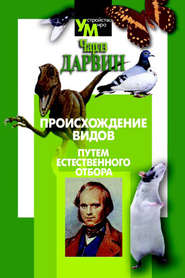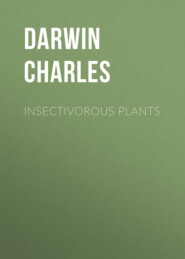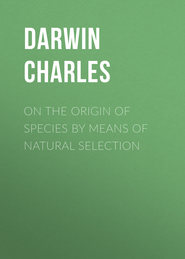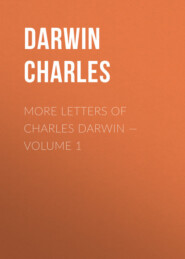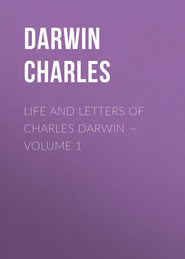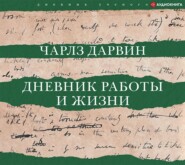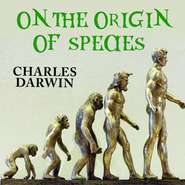По всем вопросам обращайтесь на: info@litportal.ru
(©) 2003-2024.
✖
The Origin of Species by Means of Natural Selection
Настройки чтения
Размер шрифта
Высота строк
Поля
MULTIPLE, RUDIMENTARY, AND LOWLY-ORGANISED STRUCTURES ARE VARIABLE.
It seems to be a rule, as remarked by Is. Geoffroy St. Hilaire, both with varieties and species, that when any part or organ is repeated many times in the same individual (as the vertebrae in snakes, and the stamens in polyandrous flowers) the number is variable; whereas the number of the same part or organ, when it occurs in lesser numbers, is constant. The same author as well as some botanists, have further remarked that multiple parts are extremely liable to vary in structure. As "vegetative repetition," to use Professor Owen's expression, is a sign of low organisation; the foregoing statements accord with the common opinion of naturalists, that beings which stand low in the scale of nature are more variable than those which are higher. I presume that lowness here means that the several parts of the organisation have been but little specialised for particular functions; and as long as the same part has to perform diversified work, we can perhaps see why it should remain variable, that is, why natural selection should not have preserved or rejected each little deviation of form so carefully as when the part has to serve for some one special purpose. In the same way that a knife which has to cut all sorts of things may be of almost any shape; whilst a tool for some particular purpose must be of some particular shape. Natural selection, it should never be forgotten, can act solely through and for the advantage of each being.
Rudimentary parts, as is generally admitted, are apt to be highly variable. We shall have to recur to this subject; and I will here only add that their variability seems to result from their uselessness, and consequently from natural selection having had no power to check deviations in their structure.
A PART DEVELOPED IN ANY SPECIES IN AN EXTRAORDINARY DEGREE OR MANNER, IN COMPARISON WITH THE SAME PART IN ALLIED SPECIES, TENDS TO BE HIGHLY VARIABLE.
Several years ago I was much struck by a remark to the above effect made by Mr. Waterhouse. Professor Owen, also, seems to have come to a nearly similar conclusion. It is hopeless to attempt to convince any one of the truth of the above proposition without giving the long array of facts which I have collected, and which cannot possibly be here introduced. I can only state my conviction that it is a rule of high generality. I am aware of several causes of error, but I hope that I have made due allowances for them. It should be understood that the rule by no means applies to any part, however unusually developed, unless it be unusually developed in one species or in a few species in comparison with the same part in many closely allied species. Thus, the wing of the bat is a most abnormal structure in the class of mammals; but the rule would not apply here, because the whole group of bats possesses wings; it would apply only if some one species had wings developed in a remarkable manner in comparison with the other species of the same genus. The rule applies very strongly in the case of secondary sexual characters, when displayed in any unusual manner. The term, secondary sexual characters, used by Hunter, relates to characters which are attached to one sex, but are not directly connected with the act of reproduction. The rule applies to males and females; but more rarely to females, as they seldom offer remarkable secondary sexual characters. The rule being so plainly applicable in the case of secondary sexual characters, may be due to the great variability of these characters, whether or not displayed in any unusual manner – of which fact I think there can be little doubt. But that our rule is not confined to secondary sexual characters is clearly shown in the case of hermaphrodite cirripedes; I particularly attended to Mr. Waterhouse's remark, whilst investigating this order, and I am fully convinced that the rule almost always holds good. I shall, in a future work, give a list of all the more remarkable cases. I will here give only one, as it illustrates the rule in its largest application. The opercular valves of sessile cirripedes (rock barnacles) are, in every sense of the word, very important structures, and they differ extremely little even in distinct genera; but in the several species of one genus, Pyrgoma, these valves present a marvellous amount of diversification; the homologous valves in the different species being sometimes wholly unlike in shape; and the amount of variation in the individuals of the same species is so great that it is no exaggeration to state that the varieties of the same species differ more from each other in the characters derived from these important organs, than do the species belonging to other distinct genera.
As with birds the individuals of the same species, inhabiting the same country, vary extremely little, I have particularly attended to them; and the rule certainly seems to hold good in this class. I cannot make out that it applies to plants, and this would have seriously shaken my belief in its truth, had not the great variability in plants made it particularly difficult to compare their relative degrees of variability.
When we see any part or organ developed in a remarkable degree or manner in a species, the fair presumption is that it is of high importance to that species: nevertheless it is in this case eminently liable to variation. Why should this be so? On the view that each species has been independently created, with all its parts as we now see them, I can see no explanation. But on the view that groups of species are descended from some other species, and have been modified through natural selection, I think we can obtain some light. First let me make some preliminary remarks. If, in our domestic animals, any part or the whole animal be neglected, and no selection be applied, that part (for instance, the comb in the Dorking fowl) or the whole breed will cease to have a uniform character: and the breed may be said to be degenerating. In rudimentary organs, and in those which have been but little specialised for any particular purpose, and perhaps in polymorphic groups, we see a nearly parallel case; for in such cases natural selection either has not or cannot come into full play, and thus the organisation is left in a fluctuating condition. But what here more particularly concerns us is, that those points in our domestic animals, which at the present time are undergoing rapid change by continued selection, are also eminently liable to variation. Look at the individuals of the same breed of the pigeon; and see what a prodigious amount of difference there is in the beak of tumblers, in the beak and wattle of carriers, in the carriage and tail of fantails, etc., these being the points now mainly attended to by English fanciers. Even in the same sub-breed, as in that of the short-faced tumbler, it is notoriously difficult to breed nearly perfect birds, many departing widely from the standard. There may truly be said to be a constant struggle going on between, on the one hand, the tendency to reversion to a less perfect state, as well as an innate tendency to new variations, and, on the other hand, the power of steady selection to keep the breed true. In the long run selection gains the day, and we do not expect to fail so completely as to breed a bird as coarse as a common tumbler pigeon from a good short-faced strain. But as long as selection is rapidly going on, much variability in the parts undergoing modification may always be expected.
Now let us turn to nature. When a part has been developed in an extraordinary manner in any one species, compared with the other species of the same genus, we may conclude that this part has undergone an extraordinary amount of modification since the period when the several species branched off from the common progenitor of the genus. This period will seldom be remote in any extreme degree, as species rarely endure for more than one geological period. An extraordinary amount of modification implies an unusually large and long-continued amount of variability, which has continually been accumulated by natural selection for the benefit of the species. But as the variability of the extraordinarily developed part or organ has been so great and long-continued within a period not excessively remote, we might, as a general rule, still expect to find more variability in such parts than in other parts of the organisation which have remained for a much longer period nearly constant. And this, I am convinced, is the case. That the struggle between natural selection on the one hand, and the tendency to reversion and variability on the other hand, will in the course of time cease; and that the most abnormally developed organs may be made constant, I see no reason to doubt. Hence, when an organ, however abnormal it may be, has been transmitted in approximately the same condition to many modified descendants, as in the case of the wing of the bat, it must have existed, according to our theory, for an immense period in nearly the same state; and thus it has come not to be more variable than any other structure. It is only in those cases in which the modification has been comparatively recent and extraordinarily great that we ought to find the GENERATIVE VARIABILITY, as it may be called, still present in a high degree. For in this case the variability will seldom as yet have been fixed by the continued selection of the individuals varying in the required manner and degree, and by the continued rejection of those tending to revert to a former and less modified condition.
SPECIFIC CHARACTERS MORE VARIABLE THAN GENERIC CHARACTERS.
The principle discussed under the last heading may be applied to our present subject. It is notorious that specific characters are more variable than generic. To explain by a simple example what is meant: if in a large genus of plants some species had blue flowers and some had red, the colour would be only a specific character, and no one would be surprised at one of the blue species varying into red, or conversely; but if all the species had blue flowers, the colour would become a generic character, and its variation would be a more unusual circumstance. I have chosen this example because the explanation which most naturalists would advance is not here applicable, namely, that specific characters are more variable than generic, because they are taken from parts of less physiological importance than those commonly used for classing genera. I believe this explanation is partly, yet only indirectly, true; I shall, however, have to return to this point in the chapter on Classification. It would be almost superfluous to adduce evidence in support of the statement, that ordinary specific characters are more variable than generic; but with respect to important characters, I have repeatedly noticed in works on natural history, that when an author remarks with surprise that some important organ or part, which is generally very constant throughout a large group of species, DIFFERS considerably in closely-allied species, it is often VARIABLE in the individuals of the same species. And this fact shows that a character, which is generally of generic value, when it sinks in value and becomes only of specific value, often becomes variable, though its physiological importance may remain the same. Something of the same kind applies to monstrosities: at least Is. Geoffroy St. Hilaire apparently entertains no doubt, that the more an organ normally differs in the different species of the same group, the more subject it is to anomalies in the individuals.
On the ordinary view of each species having been independently created, why should that part of the structure, which differs from the same part in other independently created species of the same genus, be more variable than those parts which are closely alike in the several species? I do not see that any explanation can be given. But on the view that species are only strongly marked and fixed varieties, we might expect often to find them still continuing to vary in those parts of their structure which have varied within a moderately recent period, and which have thus come to differ. Or to state the case in another manner: the points in which all the species of a genus resemble each other, and in which they differ from allied genera, are called generic characters; and these characters may be attributed to inheritance from a common progenitor, for it can rarely have happened that natural selection will have modified several distinct species, fitted to more or less widely different habits, in exactly the same manner: and as these so-called generic characters have been inherited from before the period when the several species first branched off from their common progenitor, and subsequently have not varied or come to differ in any degree, or only in a slight degree, it is not probable that they should vary at the present day. On the other hand, the points in which species differ from other species of the same genus are called specific characters; and as these specific characters have varied and come to differ since the period when the species branched off from a common progenitor, it is probable that they should still often be in some degree variable – at least more variable than those parts of the organisation which have for a very long period remained constant.
SECONDARY SEXUAL CHARACTERS VARIABLE.
I think it will be admitted by naturalists, without my entering on details, that secondary sexual characters are highly variable. It will also be admitted that species of the same group differ from each other more widely in their secondary sexual characters, than in other parts of their organisation; compare, for instance, the amount of difference between the males of gallinaceous birds, in which secondary sexual characters are strongly displayed, with the amount of difference between the females. The cause of the original variability of these characters is not manifest; but we can see why they should not have been rendered as constant and uniform as others, for they are accumulated by sexual selection, which is less rigid in its action than ordinary selection, as it does not entail death, but only gives fewer offspring to the less favoured males. Whatever the cause may be of the variability of secondary sexual characters, as they are highly variable, sexual selection will have had a wide scope for action, and may thus have succeeded in giving to the species of the same group a greater amount of difference in these than in other respects.
It is a remarkable fact, that the secondary differences between the two sexes of the same species are generally displayed in the very same parts of the organisation in which the species of the same genus differ from each other. Of this fact I will give in illustration the first two instances which happen to stand on my list; and as the differences in these cases are of a very unusual nature, the relation can hardly be accidental. The same number of joints in the tarsi is a character common to very large groups of beetles, but in the Engidae, as Westwood has remarked, the number varies greatly and the number likewise differs in the two sexes of the same species. Again in the fossorial hymenoptera, the neuration of the wings is a character of the highest importance, because common to large groups; but in certain genera the neuration differs in the different species, and likewise in the two sexes of the same species. Sir J. Lubbock has recently remarked, that several minute crustaceans offer excellent illustrations of this law. "In Pontella, for instance, the sexual characters are afforded mainly by the anterior antennae and by the fifth pair of legs: the specific differences also are principally given by these organs." This relation has a clear meaning on my view: I look at all the species of the same genus as having as certainly descended from the same progenitor, as have the two sexes of any one species. Consequently, whatever part of the structure of the common progenitor, or of its early descendants, became variable; variations of this part would, it is highly probable, be taken advantage of by natural and sexual selection, in order to fit the several places in the economy of nature, and likewise to fit the two sexes of the same species to each other, or to fit the males to struggle with other males for the possession of the females.
Finally, then, I conclude that the greater variability of specific characters, or those which distinguish species from species, than of generic characters, or those which are possessed by all the species; that the frequent extreme variability of any part which is developed in a species in an extraordinary manner in comparison with the same part in its congeners; and the slight degree of variability in a part, however extraordinarily it may be developed, if it be common to a whole group of species; that the great variability of secondary sexual characters and their great difference in closely allied species; that secondary sexual and ordinary specific differences are generally displayed in the same parts of the organisation, are all principles closely connected together. All being mainly due to the species of the same group being the descendants of a common progenitor, from whom they have inherited much in common, to parts which have recently and largely varied being more likely still to go on varying than parts which have long been inherited and have not varied, to natural selection having more or less completely, according to the lapse of time, overmastered the tendency to reversion and to further variability, to sexual selection being less rigid than ordinary selection, and to variations in the same parts having been accumulated by natural and sexual selection, and thus having been adapted for secondary sexual, and for ordinary purposes.
DISTINCT SPECIES PRESENT ANALOGOUS VARIATIONS, SO THAT A VARIETY OF ONE SPECIES OFTEN ASSUMES A CHARACTER PROPER TO AN ALLIED SPECIES, OR REVERTS TO SOME OF THE CHARACTERS OF AN EARLY PROGENITOR.
These propositions will be most readily understood by looking to our domestic races. The most distinct breeds of the pigeon, in countries widely apart, present sub-varieties with reversed feathers on the head, and with feathers on the feet, characters not possessed by the aboriginal rock-pigeon; these then are analogous variations in two or more distinct races. The frequent presence of fourteen or even sixteen tail-feathers in the pouter may be considered as a variation representing the normal structure of another race, the fantail. I presume that no one will doubt that all such analogous variations are due to the several races of the pigeon having inherited from a common parent the same constitution and tendency to variation, when acted on by similar unknown influences. In the vegetable kingdom we have a case of analogous variation, in the enlarged stems, or as commonly called roots, of the Swedish turnip and ruta-baga, plants which several botanists rank as varieties produced by cultivation from a common parent: if this be not so, the case will then be one of analogous variation in two so-called distinct species; and to these a third may be added, namely, the common turnip. According to the ordinary view of each species having been independently created, we should have to attribute this similarity in the enlarged stems of these three plants, not to the vera causa of community of descent, and a consequent tendency to vary in a like manner, but to three separate yet closely related acts of creation. Many similar cases of analogous variation have been observed by Naudin in the great gourd family, and by various authors in our cereals. Similar cases occurring with insects under natural conditions have lately been discussed with much ability by Mr. Walsh, who has grouped them under his law of equable variability.
With pigeons, however, we have another case, namely, the occasional appearance in all the breeds, of slaty-blue birds with two black bars on the wings, white loins, a bar at the end of the tail, with the outer feathers externally edged near their bases with white. As all these marks are characteristic of the parent rock-pigeon, I presume that no one will doubt that this is a case of reversion, and not of a new yet analogous variation appearing in the several breeds. We may, I think, confidently come to this conclusion, because, as we have seen, these coloured marks are eminently liable to appear in the crossed offspring of two distinct and differently coloured breeds; and in this case there is nothing in the external conditions of life to cause the reappearance of the slaty-blue, with the several marks, beyond the influence of the mere act of crossing on the laws of inheritance.
No doubt it is a very surprising fact that characters should reappear after having been lost for many, probably for hundreds of generations. But when a breed has been crossed only once by some other breed, the offspring occasionally show for many generations a tendency to revert in character to the foreign breed – some say, for a dozen or even a score of generations. After twelve generations, the proportion of blood, to use a common expression, from one ancestor, is only 1 in 2048; and yet, as we see, it is generally believed that a tendency to reversion is retained by this remnant of foreign blood. In a breed which has not been crossed, but in which BOTH parents have lost some character which their progenitor possessed, the tendency, whether strong or weak, to reproduce the lost character might, as was formerly remarked, for all that we can see to the contrary, be transmitted for almost any number of generations. When a character which has been lost in a breed, reappears after a great number of generations, the most probable hypothesis is, not that one individual suddenly takes after an ancestor removed by some hundred generations, but that in each successive generation the character in question has been lying latent, and at last, under unknown favourable conditions, is developed. With the barb-pigeon, for instance, which very rarely produces a blue bird, it is probable that there is a latent tendency in each generation to produce blue plumage. The abstract improbability of such a tendency being transmitted through a vast number of generations, is not greater than that of quite useless or rudimentary organs being similarly transmitted. A mere tendency to produce a rudiment is indeed sometimes thus inherited.
As all the species of the same genus are supposed to be descended from a common progenitor, it might be expected that they would occasionally vary in an analogous manner; so that the varieties of two or more species would resemble each other, or that a variety of one species would resemble in certain characters another and distinct species, this other species being, according to our view, only a well-marked and permanent variety. But characters exclusively due to analogous variation would probably be of an unimportant nature, for the preservation of all functionally important characters will have been determined through natural selection, in accordance with the different habits of the species. It might further be expected that the species of the same genus would occasionally exhibit reversions to long-lost characters. As, however, we do not know the common ancestor of any natural group, we cannot distinguish between reversionary and analogous characters. If, for instance, we did not know that the parent rock-pigeon was not feather-footed or turn-crowned, we could not have told, whether such characters in our domestic breeds were reversions or only analogous variations; but we might have inferred that the blue colour was a case of reversion from the number of the markings, which are correlated with this tint, and which would not probably have all appeared together from simple variation. More especially we might have inferred this from the blue colour and the several marks so often appearing when differently coloured breeds are crossed. Hence, although under nature it must generally be left doubtful, what cases are reversions to formerly existing characters, and what are new but analogous variations, yet we ought, on our theory, sometimes to find the varying offspring of a species assuming characters which are already present in other members of the same group. And this undoubtedly is the case.
The difficulty in distinguishing variable species is largely due to the varieties mocking, as it were, other species of the same genus. A considerable catalogue, also, could be given of forms intermediate between two other forms, which themselves can only doubtfully be ranked as species; and this shows, unless all these closely allied forms be considered as independently created species, that they have in varying assumed some of the characters of the others. But the best evidence of analogous variations is afforded by parts or organs which are generally constant in character, but which occasionally vary so as to resemble, in some degree, the same part or organ in an allied species. I have collected a long list of such cases; but here, as before, I lie under the great disadvantage of not being able to give them. I can only repeat that such cases certainly occur, and seem to me very remarkable.
I will, however, give one curious and complex case, not indeed as affecting any important character, but from occurring in several species of the same genus, partly under domestication and partly under nature. It is a case almost certainly of reversion. The ass sometimes has very distinct transverse bars on its legs, like those on the legs of a zebra. It has been asserted that these are plainest in the foal, and from inquiries which I have made, I believe this to be true. The stripe on the shoulder is sometimes double, and is very variable in length and outline. A white ass, but NOT an albino, has been described without either spinal or shoulder stripe; and these stripes are sometimes very obscure, or actually quite lost, in dark-coloured asses. The koulan of Pallas is said to have been seen with a double shoulder-stripe. Mr. Blyth has seen a specimen of the hemionus with a distinct shoulder-stripe, though it properly has none; and I have been informed by Colonel Poole that foals of this species are generally striped on the legs and faintly on the shoulder. The quagga, though so plainly barred like a zebra over the body, is without bars on the legs; but Dr. Gray has figured one specimen with very distinct zebra-like bars on the hocks.
With respect to the horse, I have collected cases in England of the spinal stripe in horses of the most distinct breeds, and of ALL colours; transverse bars on the legs are not rare in duns, mouse-duns, and in one instance in a chestnut; a faint shoulder-stripe may sometimes be seen in duns, and I have seen a trace in a bay horse. My son made a careful examination and sketch for me of a dun Belgian cart-horse with a double stripe on each shoulder and with leg-stripes. I have myself seen a dun Devonshire pony, and a small dun Welsh pony has been carefully described to me, both with THREE parallel stripes on each shoulder.
In the northwest part of India the Kattywar breed of horses is so generally striped, that, as I hear from Colonel Poole, who examined this breed for the Indian Government, a horse without stripes is not considered as purely bred. The spine is always striped; the legs are generally barred; and the shoulder-stripe, which is sometimes double and sometimes treble, is common; the side of the face, moreover, is sometimes striped. The stripes are often plainest in the foal; and sometimes quite disappear in old horses. Colonel Poole has seen both gray and bay Kattywar horses striped when first foaled. I have also reason to suspect, from information given me by Mr. W.W. Edwards, that with the English race-horse the spinal stripe is much commoner in the foal than in the full-grown animal. I have myself recently bred a foal from a bay mare (offspring of a Turkoman horse and a Flemish mare) by a bay English race-horse. This foal, when a week old, was marked on its hinder quarters and on its forehead with numerous very narrow, dark, zebra-like bars, and its legs were feebly striped. All the stripes soon disappeared completely. Without here entering on further details I may state that I have collected cases of leg and shoulder stripes in horses of very different breeds in various countries from Britain to Eastern China; and from Norway in the north to the Malay Archipelago in the south. In all parts of the world these stripes occur far oftenest in duns and mouse-duns; by the term dun a large range of colour is included, from one between brown and black to a close approach to cream colour.
I am aware that Colonel Hamilton Smith, who has written on this subject, believes that the several breeds of the horse are descended from several aboriginal species, one of which, the dun, was striped; and that the above-described appearances are all due to ancient crosses with the dun stock. But this view may be safely rejected, for it is highly improbable that the heavy Belgian cart-horse, Welsh ponies, Norwegian cobs, the lanky Kattywar race, etc., inhabiting the most distant parts of the world, should have all have been crossed with one supposed aboriginal stock.
Now let us turn to the effects of crossing the several species of the horse genus. Rollin asserts that the common mule from the ass and horse is particularly apt to have bars on its legs; according to Mr. Gosse, in certain parts of the United States, about nine out of ten mules have striped legs. I once saw a mule with its legs so much striped that any one might have thought that it was a hybrid zebra; and Mr. W.C. Martin, in his excellent treatise on the horse, has given a figure of a similar mule. In four coloured drawings, which I have seen, of hybrids between the ass and zebra, the legs were much more plainly barred than the rest of the body; and in one of them there was a double shoulder-stripe. In Lord Morton's famous hybrid, from a chestnut mare and male quagga, the hybrid and even the pure offspring subsequently produced from the same mare by a black Arabian sire, were much more plainly barred across the legs than is even the pure quagga. Lastly, and this is another most remarkable case, a hybrid has been figured by Dr. Gray (and he informs me that he knows of a second case) from the ass and the hemionus; and this hybrid, though the ass only occasionally has stripes on his legs and the hemionus has none and has not even a shoulder-stripe, nevertheless had all four legs barred, and had three short shoulder-stripes, like those on the dun Devonshire and Welsh ponies, and even had some zebra-like stripes on the sides of its face. With respect to this last fact, I was so convinced that not even a stripe of colour appears from what is commonly called chance, that I was led solely from the occurrence of the face-stripes on this hybrid from the ass and hemionus to ask Colonel Poole whether such face-stripes ever occurred in the eminently striped Kattywar breed of horses, and was, as we have seen, answered in the affirmative.
What now are we to say to these several facts? We see several distinct species of the horse genus becoming, by simple variation, striped on the legs like a zebra, or striped on the shoulders like an ass. In the horse we see this tendency strong whenever a dun tint appears – a tint which approaches to that of the general colouring of the other species of the genus. The appearance of the stripes is not accompanied by any change of form, or by any other new character. We see this tendency to become striped most strongly displayed in hybrids from between several of the most distinct species. Now observe the case of the several breeds of pigeons: they are descended from a pigeon (including two or three sub-species or geographical races) of a bluish colour, with certain bars and other marks; and when any breed assumes by simple variation a bluish tint, these bars and other marks invariably reappear; but without any other change of form or character. When the oldest and truest breeds of various colours are crossed, we see a strong tendency for the blue tint and bars and marks to reappear in the mongrels. I have stated that the most probable hypothesis to account for the reappearance of very ancient characters, is – that there is a TENDENCY in the young of each successive generation to produce the long-lost character, and that this tendency, from unknown causes, sometimes prevails. And we have just seen that in several species of the horse genus the stripes are either plainer or appear more commonly in the young than in the old. Call the breeds of pigeons, some of which have bred true for centuries, species; and how exactly parallel is the case with that of the species of the horse genus! For myself, I venture confidently to look back thousands on thousands of generations, and I see an animal striped like a zebra, but perhaps otherwise very differently constructed, the common parent of our domestic horse (whether or not it be descended from one or more wild stocks) of the ass, the hemionus, quagga, and zebra.
He who believes that each equine species was independently created, will, I presume, assert that each species has been created with a tendency to vary, both under nature and under domestication, in this particular manner, so as often to become striped like the other species of the genus; and that each has been created with a strong tendency, when crossed with species inhabiting distant quarters of the world, to produce hybrids resembling in their stripes, not their own parents, but other species of the genus. To admit this view is, as it seems to me, to reject a real for an unreal, or at least for an unknown cause. It makes the works of God a mere mockery and deception; I would almost as soon believe with the old and ignorant cosmogonists, that fossil shells had never lived, but had been created in stone so as to mock the shells now living on the sea-shore.
SUMMARY.
Our ignorance of the laws of variation is profound. Not in one case out of a hundred can we pretend to assign any reason why this or that part has varied. But whenever we have the means of instituting a comparison, the same laws appear to have acted in producing the lesser differences between varieties of the same species, and the greater differences between species of the same genus. Changed conditions generally induce mere fluctuating variability, but sometimes they cause direct and definite effects; and these may become strongly marked in the course of time, though we have not sufficient evidence on this head. Habit in producing constitutional peculiarities, and use in strengthening, and disuse in weakening and diminishing organs, appear in many cases to have been potent in their effects. Homologous parts tend to vary in the same manner, and homologous parts tend to cohere. Modifications in hard parts and in external parts sometimes affect softer and internal parts. When one part is largely developed, perhaps it tends to draw nourishment from the adjoining parts; and every part of the structure which can be saved without detriment will be saved. Changes of structure at an early age may affect parts subsequently developed; and many cases of correlated variation, the nature of which we are unable to understand, undoubtedly occur. Multiple parts are variable in number and in structure, perhaps arising from such parts not having been closely specialised for any particular function, so that their modifications have not been closely checked by natural selection. It follows probably from this same cause, that organic beings low in the scale are more variable than those standing higher in the scale, and which have their whole organisation more specialised. Rudimentary organs, from being useless, are not regulated by natural selection, and hence are variable. Specific characters – that is, the characters which have come to differ since the several species of the same genus branched off from a common parent – are more variable than generic characters, or those which have long been inherited, and have not differed within this same period. In these remarks we have referred to special parts or organs being still variable, because they have recently varied and thus come to differ; but we have also seen in the second chapter that the same principle applies to the whole individual; for in a district where many species of a genus are found – that is, where there has been much former variation and differentiation, or where the manufactory of new specific forms has been actively at work – in that district and among these species, we now find, on an average, most varieties. Secondary sexual characters are highly variable, and such characters differ much in the species of the same group. Variability in the same parts of the organisation has generally been taken advantage of in giving secondary sexual differences to the two sexes of the same species, and specific differences to the several species of the same genus. Any part or organ developed to an extraordinary size or in an extraordinary manner, in comparison with the same part or organ in the allied species, must have gone through an extraordinary amount of modification since the genus arose; and thus we can understand why it should often still be variable in a much higher degree than other parts; for variation is a long-continued and slow process, and natural selection will in such cases not as yet have had time to overcome the tendency to further variability and to reversion to a less modified state. But when a species with an extraordinarily developed organ has become the parent of many modified descendants – which on our view must be a very slow process, requiring a long lapse of time – in this case, natural selection has succeeded in giving a fixed character to the organ, in however extraordinary a manner it may have been developed. Species inheriting nearly the same constitution from a common parent, and exposed to similar influences, naturally tend to present analogous variations, or these same species may occasionally revert to some of the characters of their ancient progenitors. Although new and important modifications may not arise from reversion and analogous variation, such modifications will add to the beautiful and harmonious diversity of nature.
Whatever the cause may be of each slight difference between the offspring and their parents – and a cause for each must exist – we have reason to believe that it is the steady accumulation of beneficial differences which has given rise to all the more important modifications of structure in relation to the habits of each species.
CHAPTER VI. DIFFICULTIES OF THE THEORY
Difficulties of the theory of descent with modification – Absence or rarity of transitional varieties – Transitions in habits of life – Diversified habits in the same species – Species with habits widely different from those of their allies – Organs of extreme perfection – Modes of transition – Cases of difficulty – Natura non facit saltum – Organs of small importance – Organs not in all cases absolutely perfect – The law of Unity of Type and of the Conditions of Existence embraced by the theory of Natural Selection.
Long before the reader has arrived at this part of my work, a crowd of difficulties will have occurred to him. Some of them are so serious that to this day I can hardly reflect on them without being in some degree staggered; but, to the best of my judgment, the greater number are only apparent, and those that are real are not, I think, fatal to the theory.
These difficulties and objections may be classed under the following heads: First, why, if species have descended from other species by fine gradations, do we not everywhere see innumerable transitional forms? Why is not all nature in confusion, instead of the species being, as we see them, well defined?
Secondly, is it possible that an animal having, for instance, the structure and habits of a bat, could have been formed by the modification of some other animal with widely different habits and structure? Can we believe that natural selection could produce, on the one hand, an organ of trifling importance, such as the tail of a giraffe, which serves as a fly-flapper, and, on the other hand, an organ so wonderful as the eye?
Thirdly, can instincts be acquired and modified through natural selection? What shall we say to the instinct which leads the bee to make cells, and which has practically anticipated the discoveries of profound mathematicians?
Fourthly, how can we account for species, when crossed, being sterile and producing sterile offspring, whereas, when varieties are crossed, their fertility is unimpaired?
The two first heads will be here discussed; some miscellaneous objections in the following chapter; Instinct and Hybridism in the two succeeding chapters.
ON THE ABSENCE OR RARITY OF TRANSITIONAL VARIETIES.
As natural selection acts solely by the preservation of profitable modifications, each new form will tend in a fully-stocked country to take the place of, and finally to exterminate, its own less improved parent-form and other less-favoured forms with which it comes into competition. Thus extinction and natural selection go hand in hand. Hence, if we look at each species as descended from some unknown form, both the parent and all the transitional varieties will generally have been exterminated by the very process of the formation and perfection of the new form.
But, as by this theory innumerable transitional forms must have existed, why do we not find them embedded in countless numbers in the crust of the earth? It will be more convenient to discuss this question in the chapter on the imperfection of the geological record; and I will here only state that I believe the answer mainly lies in the record being incomparably less perfect than is generally supposed. The crust of the earth is a vast museum; but the natural collections have been imperfectly made, and only at long intervals of time.
But it may be urged that when several closely allied species inhabit the same territory, we surely ought to find at the present time many transitional forms. Let us take a simple case: in travelling from north to south over a continent, we generally meet at successive intervals with closely allied or representative species, evidently filling nearly the same place in the natural economy of the land. These representative species often meet and interlock; and as the one becomes rarer and rarer, the other becomes more and more frequent, till the one replaces the other. But if we compare these species where they intermingle, they are generally as absolutely distinct from each other in every detail of structure as are specimens taken from the metropolis inhabited by each. By my theory these allied species are descended from a common parent; and during the process of modification, each has become adapted to the conditions of life of its own region, and has supplanted and exterminated its original parent-form and all the transitional varieties between its past and present states. Hence we ought not to expect at the present time to meet with numerous transitional varieties in each region, though they must have existed there, and may be embedded there in a fossil condition. But in the intermediate region, having intermediate conditions of life, why do we not now find closely-linking intermediate varieties? This difficulty for a long time quite confounded me. But I think it can be in large part explained.
In the first place we should be extremely cautious in inferring, because an area is now continuous, that it has been continuous during a long period. Geology would lead us to believe that most continents have been broken up into islands even during the later tertiary periods; and in such islands distinct species might have been separately formed without the possibility of intermediate varieties existing in the intermediate zones. By changes in the form of the land and of climate, marine areas now continuous must often have existed within recent times in a far less continuous and uniform condition than at present. But I will pass over this way of escaping from the difficulty; for I believe that many perfectly defined species have been formed on strictly continuous areas; though I do not doubt that the formerly broken condition of areas now continuous, has played an important part in the formation of new species, more especially with freely-crossing and wandering animals.
In looking at species as they are now distributed over a wide area, we generally find them tolerably numerous over a large territory, then becoming somewhat abruptly rarer and rarer on the confines, and finally disappearing. Hence the neutral territory between two representative species is generally narrow in comparison with the territory proper to each. We see the same fact in ascending mountains, and sometimes it is quite remarkable how abruptly, as Alph. De Candolle has observed, a common alpine species disappears. The same fact has been noticed by E. Forbes in sounding the depths of the sea with the dredge. To those who look at climate and the physical conditions of life as the all-important elements of distribution, these facts ought to cause surprise, as climate and height or depth graduate away insensibly. But when we bear in mind that almost every species, even in its metropolis, would increase immensely in numbers, were it not for other competing species; that nearly all either prey on or serve as prey for others; in short, that each organic being is either directly or indirectly related in the most important manner to other organic beings – we see that the range of the inhabitants of any country by no means exclusively depends on insensibly changing physical conditions, but in large part on the presence of other species, on which it lives, or by which it is destroyed, or with which it comes into competition; and as these species are already defined objects, not blending one into another by insensible gradations, the range of any one species, depending as it does on the range of others, will tend to be sharply defined. Moreover, each species on the confines of its range, where it exists in lessened numbers, will, during fluctuations in the number of its enemies or of its prey, or in the nature of the seasons, be extremely liable to utter extermination; and thus its geographical range will come to be still more sharply defined.
As allied or representative species, when inhabiting a continuous area, are generally distributed in such a manner that each has a wide range, with a comparatively narrow neutral territory between them, in which they become rather suddenly rarer and rarer; then, as varieties do not essentially differ from species, the same rule will probably apply to both; and if we take a varying species inhabiting a very large area, we shall have to adapt two varieties to two large areas, and a third variety to a narrow intermediate zone. The intermediate variety, consequently, will exist in lesser numbers from inhabiting a narrow and lesser area; and practically, as far as I can make out, this rule holds good with varieties in a state of nature. I have met with striking instances of the rule in the case of varieties intermediate between well-marked varieties in the genus Balanus. And it would appear from information given me by Mr. Watson, Dr. Asa Gray, and Mr. Wollaston, that generally, when varieties intermediate between two other forms occur, they are much rarer numerically than the forms which they connect. Now, if we may trust these facts and inferences, and conclude that varieties linking two other varieties together generally have existed in lesser numbers than the forms which they connect, then we can understand why intermediate varieties should not endure for very long periods: why, as a general rule, they should be exterminated and disappear, sooner than the forms which they originally linked together.
For any form existing in lesser numbers would, as already remarked, run a greater chance of being exterminated than one existing in large numbers; and in this particular case the intermediate form would be eminently liable to the inroads of closely allied forms existing on both sides of it. But it is a far more important consideration, that during the process of further modification, by which two varieties are supposed to be converted and perfected into two distinct species, the two which exist in larger numbers, from inhabiting larger areas, will have a great advantage over the intermediate variety, which exists in smaller numbers in a narrow and intermediate zone. For forms existing in larger numbers will have a better chance, within any given period, of presenting further favourable variations for natural selection to seize on, than will the rarer forms which exist in lesser numbers. Hence, the more common forms, in the race for life, will tend to beat and supplant the less common forms, for these will be more slowly modified and improved. It is the same principle which, as I believe, accounts for the common species in each country, as shown in the second chapter, presenting on an average a greater number of well-marked varieties than do the rarer species. I may illustrate what I mean by supposing three varieties of sheep to be kept, one adapted to an extensive mountainous region; a second to a comparatively narrow, hilly tract; and a third to the wide plains at the base; and that the inhabitants are all trying with equal steadiness and skill to improve their stocks by selection; the chances in this case will be strongly in favour of the great holders on the mountains or on the plains improving their breeds more quickly than the small holders on the intermediate narrow, hilly tract; and consequently the improved mountain or plain breed will soon take the place of the less improved hill breed; and thus the two breeds, which originally existed in greater numbers, will come into close contact with each other, without the interposition of the supplanted, intermediate hill variety.
To sum up, I believe that species come to be tolerably well-defined objects, and do not at any one period present an inextricable chaos of varying and intermediate links: first, because new varieties are very slowly formed, for variation is a slow process, and natural selection can do nothing until favourable individual differences or variations occur, and until a place in the natural polity of the country can be better filled by some modification of some one or more of its inhabitants. And such new places will depend on slow changes of climate, or on the occasional immigration of new inhabitants, and, probably, in a still more important degree, on some of the old inhabitants becoming slowly modified, with the new forms thus produced and the old ones acting and reacting on each other. So that, in any one region and at any one time, we ought to see only a few species presenting slight modifications of structure in some degree permanent; and this assuredly we do see.
Secondly, areas now continuous must often have existed within the recent period as isolated portions, in which many forms, more especially among the classes which unite for each birth and wander much, may have separately been rendered sufficiently distinct to rank as representative species. In this case, intermediate varieties between the several representative species and their common parent, must formerly have existed within each isolated portion of the land, but these links during the process of natural selection will have been supplanted and exterminated, so that they will no longer be found in a living state.
Thirdly, when two or more varieties have been formed in different portions of a strictly continuous area, intermediate varieties will, it is probable, at first have been formed in the intermediate zones, but they will generally have had a short duration. For these intermediate varieties will, from reasons already assigned (namely from what we know of the actual distribution of closely allied or representative species, and likewise of acknowledged varieties), exist in the intermediate zones in lesser numbers than the varieties which they tend to connect. From this cause alone the intermediate varieties will be liable to accidental extermination; and during the process of further modification through natural selection, they will almost certainly be beaten and supplanted by the forms which they connect; for these, from existing in greater numbers will, in the aggregate, present more varieties, and thus be further improved through natural selection and gain further advantages.






